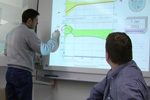 Under specific hygrothermal (temperature and humidity) conditions, various surfaces in buildings can experience mold growth. In addition to obvious aesthetic and sanitary issues, mold growth is also a significant health risk. Mold spores are known to cause various illnesses in humans. To prevent mold growth it is important to develop methods that account for transient hygrothermal boundary conditions and inform designers if the environment would support mold growth. The most important factors are temperature, humidity, and substrate material.
Under specific hygrothermal (temperature and humidity) conditions, various surfaces in buildings can experience mold growth. In addition to obvious aesthetic and sanitary issues, mold growth is also a significant health risk. Mold spores are known to cause various illnesses in humans. To prevent mold growth it is important to develop methods that account for transient hygrothermal boundary conditions and inform designers if the environment would support mold growth. The most important factors are temperature, humidity, and substrate material.
Year: 2017
WUFI® Corr – Evaluation of corrosion risk
 Decay of buildings is often related to corrosion of metallic reinforcements. If wet conditions occur on the surface of steel reinforcements, corrosion can start, unless the inserts are protected by the alkalinity of the environment. Corrosion may weaken reinforcements and produce expanding oxides that lead to the detachment of covering materials, thus being harmful for the durability of the construction and challenging for its restoration. When dealing with heritage buildings the problem becomes even more complex due to the need of non-invasive and reversible techniques. Here the only possibility is often to limit the corrosion rate by controlling moisture and temperature conditions in the assembly.
Decay of buildings is often related to corrosion of metallic reinforcements. If wet conditions occur on the surface of steel reinforcements, corrosion can start, unless the inserts are protected by the alkalinity of the environment. Corrosion may weaken reinforcements and produce expanding oxides that lead to the detachment of covering materials, thus being harmful for the durability of the construction and challenging for its restoration. When dealing with heritage buildings the problem becomes even more complex due to the need of non-invasive and reversible techniques. Here the only possibility is often to limit the corrosion rate by controlling moisture and temperature conditions in the assembly.
WUFI® FinMould
 The WUFI® FinMould add-on was developed in collaboration between the Finnish research institute VTT, the Tampere University and Fraunhofer IBP. Hannu Viitanen, Tuomo Ojanen and Juha Vinha have been dealing many years with the growth conditions of mould on wood and other building materials. The mathematic-empirical model predicts mould growth as a function of substrate material, temperature and relative humidity. For evaluation the so-called Mould Index (MI) was developed, which indicates the intensity of growth using an easy-to-understand six-point scale. Contine reading
The WUFI® FinMould add-on was developed in collaboration between the Finnish research institute VTT, the Tampere University and Fraunhofer IBP. Hannu Viitanen, Tuomo Ojanen and Juha Vinha have been dealing many years with the growth conditions of mould on wood and other building materials. The mathematic-empirical model predicts mould growth as a function of substrate material, temperature and relative humidity. For evaluation the so-called Mould Index (MI) was developed, which indicates the intensity of growth using an easy-to-understand six-point scale. Contine reading
Guideline for the hygrothermal simulation of ventilated pitched roofs
A supplementary version of the guideline for the hygrothermal simulation of ventilated pitched roofs is now online.
Now it includes:
- Parameter recommendation for simulating standard cases
- Settings for simulating constructions with absorbent undercoverage
WUFI® Pro workshop in London – Still places available!
 There are still some free places available for a WUFI® Pro workshop in London in March.
There are still some free places available for a WUFI® Pro workshop in London in March.
Find more information here: